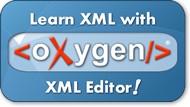XLink Example


Let's try to learn some basic XLink syntax by looking at an example.
The XML Example Document
Look at the following XML document, "bookstore.xml", that represents a few
books:
<?xml version="1.0" encoding="ISO-8859-1"?>
<bookstore xmlns:xlink="http://www.w3.org/1999/xlink">
<book title="Harry Potter">
<description
xlink:type="simple"
xlink:href="http://book.com/images/HPotter.gif"
xlink:show="new">
As his fifth year at Hogwarts School of Witchcraft and
Wizardry approaches, 15-year-old Harry Potter is.......
</description>
</book>
<book title="XQuery Kick Start">
<description
xlink:type="simple"
xlink:href="http://book.com/images/XQuery.gif"
xlink:show="new">
XQuery Kick Start delivers a concise introduction
to the XQuery standard.......
</description>
</book>
</bookstore>
|
View the "bookstore.xml" file in your
browser
In the example above the XLink namespace is declared at the top of the
document (xmlns:xlink="http://www.w3.org/1999/xlink"). This means that
the document has access to the XLink attributes and features.
The xlink:type="simple" creates a simple "HTML-like" link. You can also specify more complex links
(multidirectional links), but for now, we will only use simple links.
The xlink:href attribute specifies the URL to link to, and the xlink:show
attribute specifies where to open the link. xlink:show="new" means that the link
(in this case, an image) should open in a new window.
XLink - Going Further
In the example above we have only demonstrated simple links. XLink is getting more
interesting when we want to access remote locations as resources, instead of
standalone pages. The <description> element in the example
above sets the value of the xlink:show attribute to "new". This means that
the link should open in a new window. We could have set the value of the xlink:show
attribute to "embed". This means that the resource should be processed inline
within the page. When you consider that this could be
another XML document and not just an image, you could, for example, build a hierarchy of XML documents.
With XLink, you can also specify WHEN the resource should appear. This is handled by
the xlink:actuate attribute. xlink:actuate="onLoad" specifies that the resource should be loaded
and shown when the document loads. However, xlink:actuate="onRequest" means that
the resource is not read or shown before the link is clicked. This is very handy
for low-bandwidth settings.


Learn XML with <oXygen/> XML Editor - Free Trial!
 |
|
oXygen helps you learn to define,
edit, validate and transform XML documents. Supported technologies include XML Schema,
DTD, Relax NG, XSLT, XPath, XQuery, CSS.
Understand in no time how XSLT and XQuery work by using the intuitive oXygen debugger!
Do you have any XML related questions? Get free answers from the oXygen
XML forum
and from the video
demonstrations.
Download a FREE 30-day trial today!
|
|